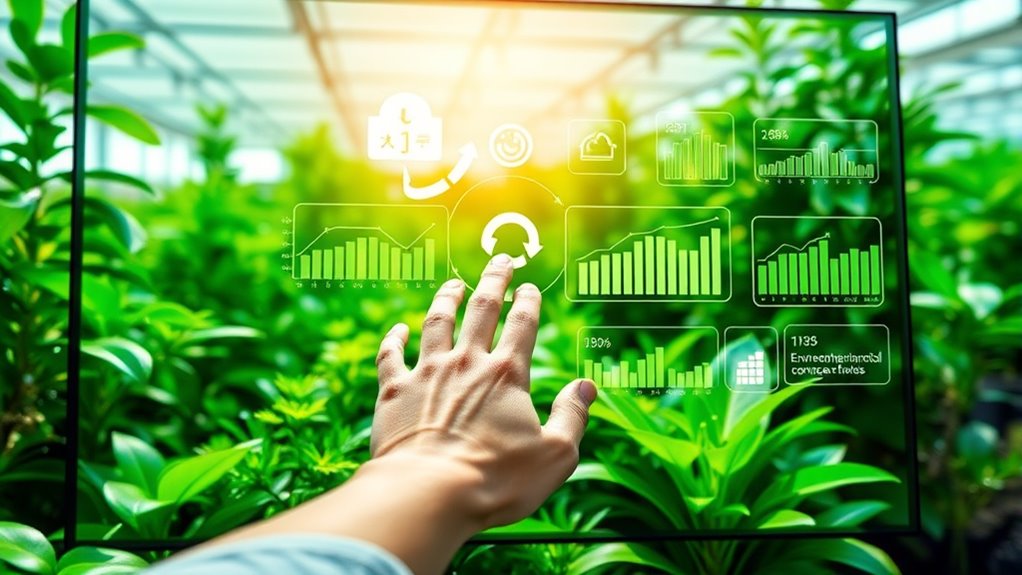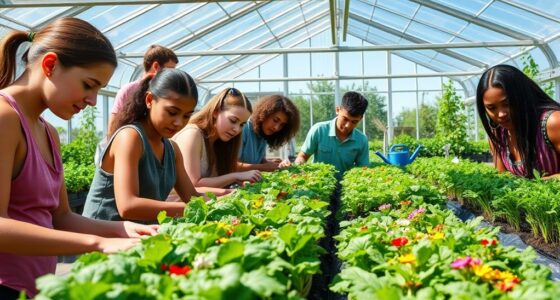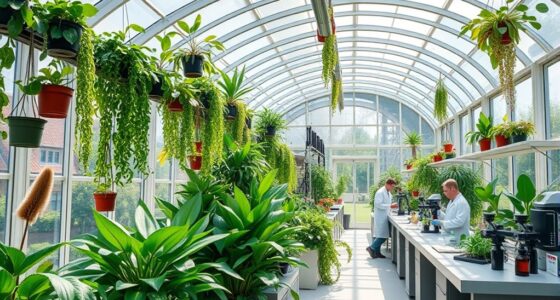If you’re exploring virtual greenhouse education platforms, you’ll find many innovative options that enhance sustainable farming knowledge. These platforms offer interactive simulations, real-time research updates, and opportunities to collaborate with experts worldwide. They allow you to experiment with variables, analyze data, and stay current with advances in plant science. By using these tools, you can deepen your understanding and stay ahead in modern agriculture practices—keep going to discover more about these dynamic learning environments.
Key Takeaways
- Offer interactive simulations to explore plant growth, soil health, and sustainable farming practices remotely.
- Facilitate collaboration among learners, educators, and experts worldwide for knowledge sharing.
- Provide access to current research, case studies, and innovations in plant science and agricultural technology.
- Enhance engagement through high-quality visuals and detailed analysis tools for complex data interpretation.
- Support experimentation with variables like light and humidity safely and cost-effectively in virtual environments.

Virtual greenhouse education platforms are transforming how we learn about plant cultivation and sustainable agriculture. These digital tools give you access to a wealth of knowledge, allowing you to explore the latest in sustainable farming practices from the comfort of your home or classroom. By using these platforms, you can immerse yourself in interactive lessons that cover everything from soil health to water conservation, make certain you stay current with evolving sustainability standards. They also serve as a bridge between traditional farming methods and cutting-edge plant science innovations, helping you understand how new technologies can improve crop yields while reducing environmental impact.
When you engage with these virtual platforms, you’re not just passively absorbing information; you’re actively participating in simulations and experiments. For example, many platforms incorporate virtual greenhouse environments where you can manipulate variables like light, humidity, and nutrient levels to see how plants respond. This hands-on approach enhances your understanding of plant physiology and the delicate balance needed for sustainable farming. Furthermore, these simulations often include data analysis tools, so you can interpret real-time results, fostering a deeper grasp of plant science innovations that are shaping modern agriculture.
These platforms also connect you with expert educators and fellow learners around the globe, creating a collaborative environment for sharing ideas and best practices. Whether you’re a student, educator, or seasoned farmer, you gain insights into innovative techniques such as hydroponics, aeroponics, and integrated pest management—all vital components of sustainable farming. As you explore these topics, you’ll see how technology is driving plant science innovations that make farming more efficient, eco-friendly, and resilient against climate change.
Connect globally with experts and learners to share innovative farming techniques like hydroponics and pest management.
Additionally, virtual greenhouse platforms often feature up-to-date research and case studies, helping you stay informed about breakthroughs in plant genetics, biomimicry, and precision agriculture. This guarantees you’re not just learning outdated methods but are equipped with current knowledge to implement sustainable practices in real-world scenarios. The interactive nature of these platforms also means you can test new concepts without risking actual crops, making experimentation safer and more cost-effective.
Moreover, understanding the importance of a high contrast ratio in projectors can greatly enhance your viewing experience, especially when analyzing detailed images or presentations related to plant science. This can make your learning environment more effective and engaging. In essence, virtual greenhouse education platforms empower you to become more knowledgeable about sustainable farming and plant science innovations. They make complex concepts accessible and engaging, fostering innovation and environmentally conscious practices. Whether you’re looking to improve your farming methods or expand your understanding of plant biology, these platforms provide a thorough, modern approach to learning that keeps pace with the rapid advancements in agricultural technology.
Frequently Asked Questions
Can Virtual Greenhouses Replace Real-World Agricultural Experiences?
You might wonder if virtual greenhouses can replace real-world agricultural experiences. While they offer valuable learning through augmented reality and gamification techniques, they can’t fully replicate hands-on farming. Virtual platforms enhance understanding and engagement, but the tactile skills and real-world challenges are best learned through actual experience. Combining both methods provides a balanced approach, ensuring you gain practical knowledge while benefiting from innovative virtual tools.
What Are the Technical Requirements for Accessing These Platforms?
To access these platforms, you need to guarantee your device has compatible hardware, like a modern computer or tablet, and supports the necessary software. Good internet connectivity is essential for smooth, real-time interactions and updates. Make sure your browser is up-to-date, and check if specific system requirements are listed. Having reliable hardware compatibility and strong internet connection guarantees you a seamless experience while exploring virtual greenhouses.
Are Virtual Greenhouse Platforms Suitable for All Age Groups?
Did you know that 85% of users find interactive interfaces engaging? Virtual greenhouse platforms are designed to be accessible for all ages, offering age-appropriate content to keep everyone interested. Whether you’re a young student or a senior, these platforms adapt with simple navigation and tailored activities. They’re suitable for all age groups because they foster curiosity and learning in a way that’s both fun and educational for everyone.
How Do These Platforms Support Sustainable Farming Education?
You can learn about sustainable practices and ecological awareness through these platforms by engaging with interactive simulations and real-world case studies. They support sustainable farming education by demonstrating eco-friendly techniques, encouraging conservation, and highlighting the importance of biodiversity. As you explore virtual greenhouses, you’ll develop a deeper understanding of how sustainable methods benefit the environment, empowering you to implement eco-conscious practices in your own farming or gardening endeavors.
What Are the Costs Involved in Using These Virtual Platforms?
You might think costs are high, but a thorough cost analysis shows many virtual greenhouse platforms offer affordable options. Subscription fees vary, with some platforms providing tiered plans to suit different budgets. While initial investments might seem steep, the savings on physical resources and travel make these platforms cost-effective. Ultimately, you’ll find that the value gained through interactive, accessible education justifies the expenses involved.
Conclusion
So, here you are, relying on virtual greenhouses to grow your knowledge—and maybe even your plants—without ever getting your hands dirty. Who knew that in a world obsessed with technology, you could literally learn to cultivate a green thumb from your couch? It’s almost poetic how these platforms make us feel connected to nature, even as we stay comfortably indoors. Ironically, the future of farming might just be a click away—no dirt required.










